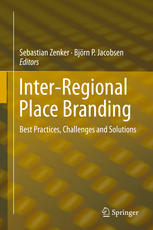Björn P. Jacobsen, Professor at Stralsund University of Applied Science in Northern Germany and former Managing Principal at Luebeck Business Development Corporation, in this interview discusses the benefits and challenges of interregional and cross-border place branding.
Learn about:
- The role and importance of place branding from an economic development point of view;
- The four kinds of places, in terms of brand;
- Interregional place branding: benefits, challenges and examples;
- How universities benefit from strong city brands, and vice versa;
- The investor-based place brand equity model.
Björn, do you remember what first attracted your interest in the study of place branding as a tool for economic development?
I became interested in place branding due to the developments I witnessed in the economic development profession. Traditionally, economic development concentrated on – and often still does – providing infrastructure, hardware and subsidies. Places tried to attract much needed investment on the basis of who was granting the biggest amount of investment incentives.
No place can win this game over the long run, so we decided to slowly move away from this strategy, and to focus our efforts on developing a place brand instead.
As a scholar with strong background in strategic place brand development, what role do you think place branding and marketing play with regard to sustainable economic development of cities or regions?
You won’t be surprised by my answer. Sustainable economic development is based on functions of a place, as well as the emotions people attach to it. Place brands – responsible for the emotional part – are therefore an important part of implementing economic development strategies.
Only investing in the functional attributes of a place is no longer enough. For us as place brand experts this seems to be clear. But for decision makers in economic development, whose primary focus has been on the real estate business for decades, this sounds like rocket science. But it is not. You just need to take the perspective of investors putting together their short list of best locations to invest in. A strong place brand (and hence place branding) is a precondition for ending up on this short list.
For today’s economic development organizations, the question is no longer if you invest in place branding, but rather how much.
In your view, what is place branding all about? And how do you distinguish between branding, marketing and economic development initiatives?
Well, I do believe to have a very simplistic view of place branding. Partly because in my profession I had to explain it again and again to political and administrative staff in an easy way. I usually distinguish four different situations of a place:
There are a large number of places which are functionally and emotionally undifferentiated. These are mere commodities (the first situation). With sensible investment into infrastructure, human resource development initiatives and technology transfer activities, these places may become functionally differentiated – I would call them a superior product (the second situation).
However, no one is really attached to them. If you now add an emotional differentiation to a superior product, you get a place brand (the third situation). That is probably the most difficult situation to reach.
The fourth situation is what we can see most frequently as place branding experts: places trying to emotionally differentiate themselves from other regions, cities or countries without a functional differentiation. This is what I would call a marketing hype or quite simply: waste of money.
Traditional infrastructure development and place marketing activities must go hand-in-hand to create a successful place brand.
My own experience of more than 20 years of economic development work is that one of the best approaches is cluster development and management. But that is a different story and would probably extent beyond this interview.
Which trends and challenges do you observe with regard to place branding, for instance in Germany or Northern Europe?
There are basically two areas of concern. The first challenge is to lift place branding to a higher spatial level. While place branding started as a national issue, now regions, cities – even villages – are using branding strategies to develop and communicate their unique offer and brand proposition.
So, the question is: How much do we need to invest in order to be recognized? My feeling is that many place branding initiatives are substantially underfunded, often because of the limited resources available. What needs to be done to overcome this challenge is cooperation on a regional level – or, if we think of the many border regions in Northern Europe, on an inter-regional level.
Why should national borders create an obstacle in branding a common region? The European Union has for long made substantial funds available through their Interreg programmes, without making real progress in creating common regions which are actually recognized. We recently conducted a research in this area and found a hand full of such examples – but still largely unknown.
Second, thinking especially about Northern Europe and Germany, we must make use and take advantage of macro-regional place branding. In Northern Europe the uniting factor – or common denominator – is the Baltic Sea. However, in place branding – regardless if we talk about attracting tourists, investors or residents – we do not make use of the Baltic Sea and its positive attributes.
I recently conducted a study on behalf of the EU strategy for the Baltic Sea Region to establish the status quo and perspectives for a joint Baltic Sea brand in the tourism area. The result was not very encouraging.
I believe that macro-regional place branding is a key to the successful economic development of areas like the Danube region, the Med area or the Baltic Sea Region.
Universities have become a vocal player in the place branding field, often featuring their host city or region in communications material aimed at attracting students. In your view, how important is the reputation/brand of a university’s location with regard to attracting potential students? And how important are universities for a city or regional brand?
Honestly, I do not have empirical data on this question available. However, I recall that we once planned a college tour with our daughter in the US. And of course the big names (or brands) had to be on the list: Yale, Harvard, MIT – all brands in themselves. But with the exception of the “M” in the MIT brand, none was referring to the location and still they are the most attractive education brands. Now, this might be an exception to the rule, but I believe that students still choose the university because of the subject. Only if they have the choice between different universities with the same subjects, the location might matter.
The situation might be similar for towns or regions using their universities in place branding. In this case universities first of all represent an infrastructure – offering potential for functional differentiation, as mentioned above. Only if the university is a brand itself, it might contribute to the place brand.
I did some research on what universities and university towns can learn from the FMCG [fast-moving consumer goods] branding – and there are some aspects they should consider. The article (in German) is available here.
How to measure a) place brand equity and b) the success or effectiveness of place branding programs?
Good question! Places in competition for inward investment increasingly apply place branding to address their target groups, but are often unable to adequately establish the effectiveness of this approach. To address this aspect I have developed the investor-based place brand equity model (IPE).
In short, the effectiveness of place brands in influencing the behaviour of inward investors can be established by identifying and applying suitable place brand attributes and place brand benefits. While place brand attributes assist the operational place brand management, place brand benefits support strategic decisions to be taken by place brand managers. The model works, but to be honest it requires considerable input data.
I have so far not come across any really good place brand equity measurements. The best model – to my knowledge – was developed years ago in South Africa to track the equity of the national place brand. But even that required considerable input data, so I believe it has since been stopped.
You recently co-edited a book on interregional place branding, together with Sebastian Zenker. Are interregional brand collaborations becoming more frequent? And which particular challenges do interregional programs have to overcome?
 Yes, this was a challenge and I must admit that Sebastian did most of the work. But basically the book [easyazon_link identifier=”B00VJI3572″ locale=”US” tag=”tpbous-20″]Inter-Regional Place Branding[/easyazon_link] was the result of an application-driven research project, in which we were both involved (to which I referred to above).
Yes, this was a challenge and I must admit that Sebastian did most of the work. But basically the book [easyazon_link identifier=”B00VJI3572″ locale=”US” tag=”tpbous-20″]Inter-Regional Place Branding[/easyazon_link] was the result of an application-driven research project, in which we were both involved (to which I referred to above).
My answer to your first question is “no”, and perhaps I should add “unfortunately”, because I am a strong believer in interregional branding. Often border regions are a little bit peripheral and cooperation across the border can really add to functional differentiation. I have witnessed this in the German-Danish border region for the last 15 years.
I believe that we must leverage the developments which have taken place in these regions and make them known, create an emotional attachment and combine this with what most people would call a lighthouse project.
Sebastian and I were lucky to find such a region in the North of Germany respective South of Denmark. The region is currently separated by water but will soon be connected by a tunnel. In fact, this is one of the largest traffic infrastructure projects in the EU [European Union] of the coming years – yet it is unknown to most people.
We believe that this region bears an enormous potential for place branding, and have developed a detailed plan to put it on the map. The big challenge is to get political support for such an approach.
Although in Europe we have been practicing interregional cooperation for some years now, when it comes to place branding everyone still thinks of their place first.
So my answer would be that making interregional and cross-border branding possible is first of all a political challenge.
Thank you, Björn.
Connect with Björn P. Jacobsen on LinkedIn.
Enjoyed our interview with Professor Dr Björn P. Jacobsen of Stralsund University of Applied Science in Northern Germany? Share and spread the word!


